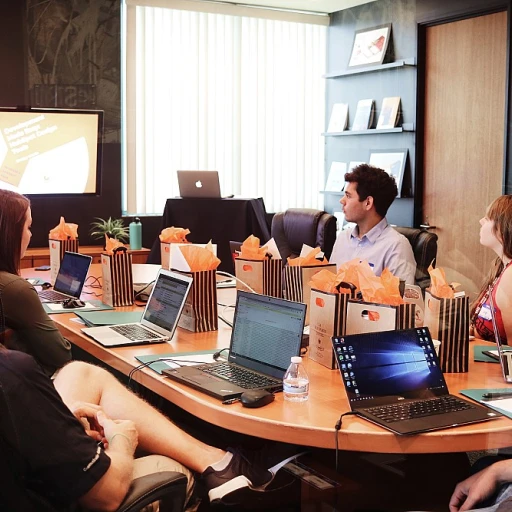
Understanding the Enterprise Mindset
Defining the Mindset That Drives Success
In today's fast-paced business world, developing an enterprise mindset is crucial for leaders and their teams. This type of thinking is essential for aligning reskilling efforts with strategic business goals and fostering a culture of continuous learning. An enterprise mindset transcends individual roles, emphasizing holistic decision-making that benefits the entire organization. Business leaders with this mindset prioritize long-term growth, understanding that talent management and reskilling play pivotal roles in sustaining a competitive edge. They recognize that an organization’s success is largely impacted by the people within it, and they strive to equip their teams with the necessary skills to adapt to changing needs and goals. To nurture such a mindset, leaders must embrace enterprise leadership. This involves encouraging collaboration across various business functions and ensuring that teams work cohesively towards common objectives. It also means recognizing the potential in employees and investing in their growth through reskilling initiatives. Enterprise leaders also understand the importance of privacy policies in aligning organizational and individual aspirations. According to recent insights from top business schools and research from Korn Ferry and Harvard Business, decision-making that considers both the individual and organizational perspectives contributes positively to the leader mindset. Organizations that cultivate an enterprise mindset create an environment where innovation and adaptability thrive. Leaders play a crucial role in embedding this thinking into the company's culture, which ultimately helps in bridging skill gaps and creating opportunities for growth. For more on how this mindset aligns with reskilling efforts, explore this understanding the role of internal equity in reskilling.Aligning Reskilling with Business Goals
Aligning Reskilling Initiatives with Organizational Goals
In today's fast-paced business environment, aligning reskilling initiatives with the overall strategy of the organization is crucial. Enterprise leaders must ensure that their reskilling programs support the business goals and drive growth. This alignment begins with a deep understanding of the company's strategic objectives and a clear vision of what the future workforce needs to achieve. An enterprise mindset requires leaders to integrate reskilling into their talent management strategy, ensuring that the skills acquired are relevant to both current and future business functions. By doing so, they can maintain a competitive edge and respond effectively to market demands. To effectively align reskilling efforts, leaders should:- Engage with Enterprise Leadership: Collaborate with different levels of management to identify key areas where reskilling can have the most impact. This engagement ensures that all parts of the organization are working towards a common goal.
- Implement a Long-term Strategy: Reskilling should not be viewed as a one-time initiative but rather as a continuous process that evolves with the company. By focusing on a long-term strategy, organizations can adapt to changes and ensure that their workforce is always equipped with necessary skills.
- Focus on Decision Making and Enterprise Thinking: As enterprise thinking involves a holistic approach to business operations, applying this mindset to reskilling helps in understanding how different roles contribute to the success of the organization. This understanding guides leaders in prioritizing skill development efforts.
- Incorporate Insights from Business Schools: Engaging with educational institutions like business schools can provide fresh perspectives and strategies that align with the latest industry trends and advancements in reskilling.
Identifying Skill Gaps and Opportunities
Pinpointing Skill Deficiencies and New Avenues
In the journey of reskilling within an enterprise, a crucial step for leaders is the identification of skill gaps and uncovering new avenues for growth. The process requires a strategic approach to comprehend the existing capabilities within the team and those needed to meet business goals.Enterprise leaders play a paramount role in assessing the current skill sets across the organization and aligning them with the company's future aspirations. This alignment is not solely about matching skills with immediate needs but also about developing an enterprise mindset that anticipates future challenges and opportunities.
Organizations must employ effective assessment tools and methodologies to map out these skill gaps. A comprehensive skills audit can provide leadership with insightful data about where employees stand relative to the demands of various business functions. This data-driven approach is essential in fostering enterprise thinking and enabling leaders to make informed decisions.
Moreover, enterprise leadership should institute a collaborative environment where teams are encouraged to engage in open dialogues about skills development. This collaborative strategy not only identifies areas for improvement but also reveals unforeseen opportunities for reskilling initiatives. By leveraging feedback from across the organization, management can devise a strategy that aligns with both current and long-term objectives.
To implement a successful reskilling plan, enterprise leaders should consider integrating insights from this process with other areas of company development. For example, initiatives such as talent management and the development of high-potential employees can significantly impact the organization's capacity to stay competitive. Reading up on how important leaders have unlocked potential in their teams offers valuable lessons (unlocking potential). Strategically identifying and cultivating the right skills within an organization paves the way for impactful decision-making and sustainable growth, positioning the company ahead in a rapidly changing business landscape.
Overcoming Challenges in Reskilling
Addressing the Hurdles in Skill Development
Tackling the challenges in reskilling is an intricate task that enterprise leaders must approach strategically. A profound enterprise mindset is pivotal in navigating the complexities associated with upskilling and reskilling within an organization. By understanding the hurdles and crafting effective solutions, leaders can foster a successful reskilling environment.
One of the primary challenges is aligning the reskilling efforts with the organization's business goals. Leadership needs to communicate the value of reskilling to all stakeholders, ensuring that teams are on board with the strategy that integrates reskilling within the broader company vision. This can ensure effective talent management and potentially transformative change across business functions.
Resistance to change is another obstacle that can impede reskilling efforts. Enterprise leaders must exhibit strong leadership mindsets, promoting a culture of continuous learning and growth. By inspiring their teams and demonstrating the long-term benefits of reskilling, leaders can reduce resistance and foster enthusiasm for development.
It's also vital to recognize the gaps in skills that need addressing, a task that requires meticulous enterprise thinking and thorough decision making. The insights provided by management can guide the organization in identifying where skills need to be developed and which strategies would have the most substantial impact. By employing a strategic approach, enterprises can ensure that the time and resources dedicated to reskilling are used effectively.
Finally, the process of reskilling is often hindered by the rapid pace of change in the business landscape. Leaders need to leverage enterprise services and technology to support reskilling initiatives, staying updated with the latest tools that can ease these transitions. Incorporating cutting-edge methods ensures that the organization remains competitive and capable of meeting evolving industry demands.
In conclusion, nurturing a leadership mindset focused on overcoming reskilling challenges is essential for developing high potential within a company. This not only impacts individual careers but drives the entire organization toward greater enterprise success.
Leveraging Technology for Reskilling
Harnessing Technology for Enhanced Learning
In today's rapidly evolving business landscape, technology has become a cornerstone for reskilling initiatives. An enterprise mindset embraces the potential of digital tools to augment traditional learning methods, enabling a more efficient and impactful upskilling experience. Digital learning platforms offer diverse, flexible solutions that align with the dynamic needs of the modern workforce. By integrating online courses, virtual simulations, and AI-driven personalizations, businesses can effectively address skill gaps and cater to the varying learning styles of their team members. Moreover, leveraging technology in reskilling offers advantages such as scalability and easy access to resources, which can help overcome geographical and temporal barriers. This opens new avenues for fostering a culture of continuous learning and development across the entire organization. However, integrating technology in reskilling is not without its challenges. Enterprise leaders must ensure that employees are equipped with the necessary digital literacy skills to make the most of new tools. Management should also remain vigilant about data security and privacy policies as they navigate this transition. Implementing an enterprise leadership mindset emphasizes the importance of creating a cohesive, innovative learning strategy. Enterprise thinking encourages potential leaders to identify and utilize technology that aligns with business goals, ensuring both immediate and long-term impacts on company performance. In summation, technology in reskilling represents an invaluable opportunity for enterprise leaders. Well-executed strategies, combined with an adaptable and forward-thinking approach, will propel businesses towards lasting success in a competitive marketplace.Fostering a Culture of Continuous Learning
Nurturing a Continuous Learning Environment
Creating a culture of continuous learning within an organization requires intentional efforts from leaders. Such an environment not only supports reskilling initiatives but enhances the overall enterprise mindset. Here are some approaches to foster continuous learning:- Promote Enterprise Thinking: Leaders must encourage employees to think beyond their immediate roles and understand the overall business functions and strategy. This broader perspective aligns with the long-term goals of the company and motivates employees to seek learning opportunities that benefit the entire organization.
- Integrate Learning into Daily Work: Rather than isolating learning as a separate activity, organizations should weave it into daily work. Practice decision making and problem-solving by engaging teams in projects that require new skills. This real-world application fosters a learning mindset and makes reskilling efforts more effective.
- Encourage Leadership and Management Support: Leaders have a significant impact on promoting a culture of learning. When management prioritizes continuous learning and reskilling, it sends a strong message to the workforce. Leaders should actively participate in learning initiatives and provide the necessary resources to support their teams.
- Leverage Technology and Resources: Utilizing advanced technology can enhance learning experiences. From e-learning platforms to virtual workshops, technology provides diverse learning options that cater to different learning styles. A well-structured learning management system ensures accessibility and tracks progression effectively.
- Celebrate Learning Achievements: Recognizing and celebrating progress boosts morale and keeps momentum. Acknowledgement from leadership for acquired skills reinforces a positive learning culture, encouraging employees to continue their development journey.













